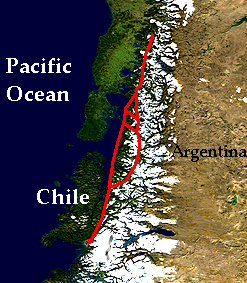
The Liquiñe-Ofqui Fault marked with red.
The Liquiñe-Ofqui Fault is major geological fault[1] that runs a length of roughly 1000 km in a north-south direction and exhibits current seismicity.[2] It is located in the Chilean northern patagonean Andes. It is a dextral intra-arc transform fault. When considered a fault zone, the Liquiñe-Ofqui Fault Zone (LOFZ) might include other neighboring faults such as Reigolil-Pirihueico Fault.
As the name implies it runs from the Liquiñe Valley hot springs in the north to the Ofqui Isthmus in the south, where the Antarctic Plate meets the Nazca Plate and the South American Plate in Chile Triple Junction. A large part of the fault runs along the Moraleda Channel. North of Liquiñe the fault is gradually converted into a compression area. At Quetrupillán volcano the fault is crossed by the Gastre Fault Zone. It may be classified as a dextral intra-arc transform fault.
The fault name was coined by F. Hervé, I. Fuenzalida, E. Araya and A. Solano in 1979.[3] The fault itself was first inferred by Chilean government agent Hans Steffen around 1900 who referred to it as a "tectonic furrow" (Spanish: surco tectónico).[3]
References
- ↑ "Revista geológica de Chile". CRED. Retrieved 1999-07-01.
- ↑ Lange, D.; Cembrano, J.; Rietbrock, A.; Haberland, C.; Dahm, T. and Bataille, K (April 2008). "First seismic record for intra-arc strike-slip tectonics along the Liquiñe-Ofqui fault zone at the obliquely convergent plate margin of the southern Andes,". Tectonophysics (Tectonophysics) 455 (1–4): 14. Bibcode:2008Tectp.455...14L. doi:10.1016/j.tecto.2008.04.014.
- ↑ 3.0 3.1 Hauser, A. 1991. HANS STEFFEN, PRECURSOR DEL CONCEPTO FALLA LIQUIÑE-OFQUI, Revista Geológica de Chile, 18, 177-179.
|
|---|
| | Morphology |
- Torres del Paine
- Valdivia
| |
|---|
| | Institutions | |
|---|
| | Lists | |
|---|
|

